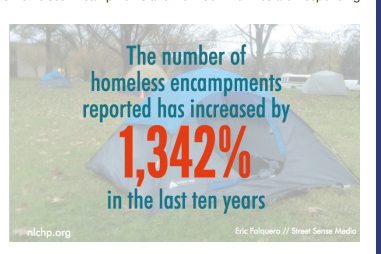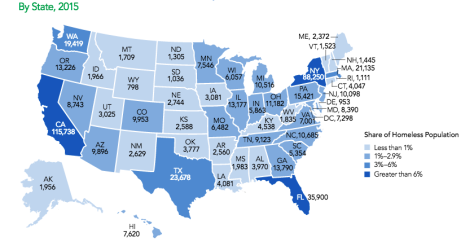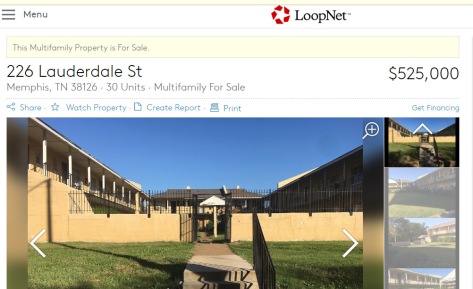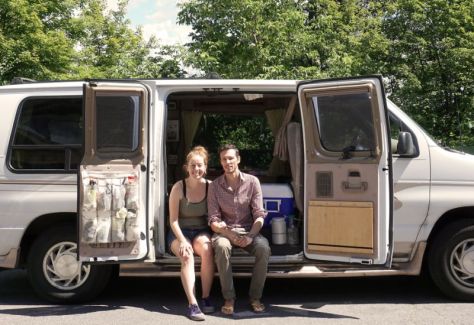As is discussed in this San Francisco Chronicle article, the problem of homelessness is growing in the United States, mostly on the West Coast, while it’s decreasing in other areas.
Cities such as Los Angeles, San Francisco, Oakland, Berkeley and San Jose are seeing rapidly exploding numbers of homeless. In Oakland, for instance, as is reported in this article and this article , the number of homeless increased 37% to 39% in just two years.
The National Law Center for Homelessness and Poverty reports that the number of homeless encampments has increased 1342% in the last ten years. See page 21 of this report:
National Law Center on Homelessness and Poverty Report

The number in California went from 6 statewide, to 120 by 2017.
In studying the approach that many cities take to solving the homeless problem, one finds a “Housing First” approach highly recommended, for the last many years. The basic idea of this approach, as described in the Wikipedia article and the following several articles, is the view that “the solution to homelessness is housing”, which is the City of Berkeley’s primary articulated approach. Utah was a poster child for this approach, when the city realized that it was less expensive to provide housing to all the homeless in the city, including the chronically homeless, than to pay for the police and emergency services continually required by those living on the streets.
The basic idea of the “Housing First” approach, is that if people are homeless, what they need is housing, so you just give them housing. This sounds so elegantly simple. It worked in Utah, why not in California? Where there’s a will, there’s a way, isn’t there?
Let’s take a look. We dont’ have to look very far to start to see some problems in importing a solution from Utah to California and the rest of the USA.
When Utah first began taking this approach to solving homelessness in 2005, there were only 2000 homeless in the entire state, whereas in California at the present time, in December 2017, there are at least 138,000 homeless people, or about 70 times as many as Utah was working with.

In the city of Oakland as of June 2017 there were 5629 homeless in Oakland, and the city of Berkeley estimates about 1000 homeless in Berkeley as of October 2017. As of January 2015, it was estimated that there were 115,738 homeless in California, and as of January 2016 that figure climbed to 118,142 people homeless in California. The numbers of homeless climbed sharply from 2016 to 2017, as in Los Angeles the number went from 44,000 to 58,000, in San Francisco the number went up by about 1000 from that in the Jan 2016 report, and in Oakland the number went up 37% so this would mean another approximately 2000 people. This means that with the increases in those three cities alone, the number of homeless in the state of California would now be at least approximately 138,000 people, out of the nation’s total 550,000 homeless. This means that the state of California has 25% of all the homeless people in the entire nation of 50 states. Which reflects what the New York Times reported in this article. By contrast, Utah has less than 1% of the number of homeless in the USA at the present time.

Homeless in Los Angeles
Hence, use of the “Housing First” model for solving homelessness, is daunted by the sheer numbers, and the exploding numbers.
In addition, the overall cost of housing and cost of living in Utah, is lower than that in the coastal cities of California, where most of California’s homeless are located. Rents are 90% higher in Los Angeles than in Salt Lake city. Rents in San Francisco are 226% higher than in Salt Lake City. Rents in Oakland are 118% higher than in Salt Lake City. These housing costs reflect costs of land, costs of construction, government fees, property taxes and other regional costs. Hence even when “affordable housing” is built in California, it costs more to build in California, particularly in Coastal California, than in Salt Lake City or elsewhere in Utah. Standard housing subsidies for those in need are very difficult to come by — in Berkeley, the last enrollment for Section 8 housing was for 5 days in March 2010, and during those 5 days, the city received 37,000 applications, of which only 1500 were selected to be placed on a wait list, and a wait list does not guarantee housing. People can remain on a wait list for Section 8 housing for many years. 
Homeless individuals are given preferential treatment over everyone else in need and assisted by funds specifically designated for the homeless. However, these funds are not unlimited. The city of Berkeley has limited funds, as well as limited space (city-owned land) to build permanent housing for the homeless, and it also has limited space and funds to build homeless shelters.
The city will spend $51 million to house 89 individuals in a Berkeley Way 6 story building, where units would cost $578,000 each to build. For the cost of housing 1 to 2 people in a $578,000 unit, the city of Berkeley could have spent $525,000 to buy this 30 unit apartment building in Memphis TN and house 30 to 60 people in it, for a total of 10% less. 
This shows some of the folly of building housing for the homeless in the cities with the most expensive housing in the United States. You get so much less for your money than if you had housed them elsewhere. So for the same dollar amount spent, you can house far fewer people in Berkeley or Oakland or San Francisco, than in Memphis, St. Louis, Tucson, Salt Lake City, or so many other places in the US. People will argue that the homeless in Berkeley will not accept being moved to Memphis, but this view is problematic in several ways, not least of which, it assumes that people have a right to housing in whatever city they happen to show up in.
Yet even if Berkeley and other California cities divert funds and resources from other areas toward more housing for the homeless, there aren’t enough funds or space to meet the growing demand. Which means that there will still be homeless tent camps on city streets, and people living in vehicles on city streets.
Cities need a plan about how to deal with those homeless whom they are unable to house in permanent housing. or whom they either cannot place in homeless shelters, or who wont’ accept space in shelters.
One of the biggest problems with our current approach to solving homelessness, is that we are doing it on a city by city basis. It’s assumed that each city is responsible for housing or sheltering those who are homeless in that city. Yet as the homeless population explodes, and as costs of housing rise, this approach will increasingly be seen as untenable. As the City of Berkeley pointed out in its recent letter to a judge who demanded that the city present a plan for housing its homeless, Berkeley has twice as many homeless as Hayward or Fremont (both of which are larger cities, Fremont has about twice the population of Berkeley) while some cities in Alameda County have no homeless people. As pointed out above, and as is seen in the map, some states have a very small percentage of all the homeless in the USA, while California now has about 25% of the total number of homeless.
These imbalances point to the need to resolve the homeless crisis at a state and national level. Homelessness is truly a national and state emergency. People who are homeless are in much the same position as those who lost homes in a fire or flood, or any other natural disaster. They need help, they need shelter, and particularly as this problem grows enormously in size, federal/state emergency funds should be available to go towards this purpose. Just like we provide shelter for flood victims with FEMA and UN assistance, or set up shelter in refugee camps for refugees, we should be setting up large state and federal camps for the homeless, where people can be gradually processed and some type of housing found for them.
Creating a central hub where homeless people can be directed to shelter and services is vital, as many cities are discovering, when they see the shortcomings of the homeless being met with a confusing array of service providers. I believe that this central hub for helping the homeless should be a federal one. The homeless would sign up with a federal office overseeing all homeless services, and then be directed to the shelter and service hub nearest their present location, to obtain shelter, food and clothing, as well as needed medical care. If a certain city has no more shelter space, the homeless would be sent to a city that did have shelter space. This approach would help prevent specific regions or cities from being overburdened, and from homeless people languishing on sidewalks and outdoors, because cities dont’ have enough shelter for them. As well, it would help prevent nuisance encampments, and protest encampments, whereby homeless protesters are enabled to extort or bully the city of their choice into giving them whatever they ask for — much like the “First they Came for the Homeless” camp is doing in Berkeley, by engaging in a sequence of encampments in prominent central places in the city for about 1.5 years now. They dont’ want shelter — they are demanding permanent housing. In Berkeley. Under a federal or state run program, it would no longer be possible for homeless protesters to bully a particular city, simply showing up wherever they want to live and demanding to be given permanent housing, because cities would no longer be responsible for housing all the homeless who show up there. Cities would not be expected to magically provide housing where there is no space for it, or funds for it when there are insufficient funds.
Do people have the right to “live” wherever they please, even if they have no resources to be able to live there? I say no, and I’m going to call this the “I want to live in Beverly Hills” logical fallacy. There are some homeless activists currently in Berkeley who are emphatic that it’s a fundamental civil right that anyone has the right to live anywhere, regardless of whether they can afford housing. These activists insist that one has the right to set up a tent on public property to house oneself, as such shelter is a fundamental right. However, if we analyze the trajectory of this concept of a civil right to live just anywhere at all, we find multiple problems. First, I think that the assertion that there’s a “civil right” to live anywhere one pleases, is a misunderstanding, and perhaps willful distortion, of the court rulings which have indicated that people have a right to sleep in public places if there is no other shelter available.
People who can’t afford any housing and are dependent on aid freely given, cannot be picky about from where they obtain this aid. Initially, the homeless would need to take shelter where it is offered. By ensuring that sufficient space is available for those in need, the government would have leverage to prohibit people camping in public places — and thus drastically reducing the nuisance, blight, crime, health risks and other social problems attending the homeless phenomenon. As people in shelter camps worked with service providers, they would be directed to places where housing and/or jobs were available. Once people got established, had a job and income and were able to stand on their own two feet again, then they could explore options and free choice about where they wanted to live. They would be able to move to any other place where they preferred to be. But what would not be permitted would be to stay in a place without a job, without housing, and without money to pay for anything, and to continue to cause a nuisance by appropriating public spaces for private use in that area.
Instead of building expensive shelters, shelters that were more similar to those provided in refugee camps and to victims of natural disasters would be used. By cutting costs, more could be sheltered. Some of this simplification of sheltering the homeless is already occurring in some Western cities, such as cities which have permitted sanctioned homeless camps, or which are doing as Oakland recently began to do, and setting up a sanctioned camp using “Tuff Shed” structures.
Video of ABC news article on Oakland’s Tuff Sheds for the homeless
This simplification of shelters, combined with the use of sanctioned camps, could help enormously in reducing the blight, crime, nuisance, garbage piles, drug use and health hazards associated with unsanctioned, ad hoc, homeless camps.
Currently, people who become homeless in a given area, are being directed to permanent housing, which often means subsidized housing, and the subsidy is larger if they are living in an area with high housing costs. How many people who are recovering from homelessness, end up being able to afford to live independently in the same city where they became homeless, and how many instead require lifelong subsidies from that point on? Studies need to be done to explore this. The goal should be to put people where they can eventually afford to live, rather than subsidize them in regions where they can never hope to afford to live.
Of course, even with all these sorts of new approaches to the homeless problem, there will still be people living on city streets. However, I think that with a smarter, more centralized approach to housing and sheltering people, and a more simplified approach to shelter construction, we could see great improvements over the current situation, and cities will not be left (as they too often are now) unable or unwilling to enforce no-camping laws.
Priority in Assigning Shelter space and housing
One of the most important things needed in helping the homeless, is studying the different kinds of homeless and finding out what are the needs of the people you’re trying to house. It’s aggravating and annoying to read simplistic articles that simply lump all the homeless into one basket, as though the person with the graduate degree who lost his job and then his house, and became homeless, is very similar at all to the convicted felon with antisocial personality disorder and an addiction to cocaine, who became homeless after being thrown out of multiple apartments for vandalism and domestic violence, and who never was able to hold a steady job.
In working with people to find housing for them, people who have the most likelihood of success in finding work to be able to stand on their own two feet, should be given priority in choosing where they want to be housed. Those who have the least likelihood of being able to find work to support themselves, or who are disabled and can’t work, should be given lowest priority to choose the particular city or region where they want to live. “Beggars can’t be choosers”. People of different need levels should be distributed evenly around the country so that no one area takes the brunt of the less functional and less employable population, but at the same time, people whose income level doesn’t match the cost of living in expensive cities, should not be housed there if they can be less expensively housed elsewhere.
This recent article studies the “bussing” of homeless from one city to another. San Francisco has done a lot of bussing of the homeless out of the city. One of the assumptions of the article is that homeless people are the responsibility of the city in which they happen to be found homeless. This is a problematic and unworkable view, particularly for West Coast cities where the homeless populations are exploding. Rather than viewing the homeless in any given city as the responsiblity of that city to shelter or house, it makes much more sense to organize housing, shelter space, and homeless services from a central federal hub.
This is how I envision this working:
(1) A person who finds themselves homeless goes to the nearest homeless service agency. This agency does an intake interview and gets them signed up through a federal registry to find housing/shelter and/or services for them.
(2) The homeless individuals’ needs are assessed, so that they can be matched with the appropriate program. At minimum, these needs are evaluated:
(a) Does the individual have skills enabling to readily find work, and if so, where can such work be found. If not, does the individual have the capacity and/or willingness to learn skills which will enable them to find work.
(b) Does the individual have a mental or physical disability which makes it difficult or impossible for them to work.
(c) Does the individual have a problem with drugs/substances which impairs their ability to function or be employed.
(d) Does the individual have a serious mental illness, and if so, what are their needs relative to this problem.
(e) Does the homeless individual have family and friends in any part of the nation or world who could help them.
(f) Does the individual have a criminal record which make it difficult to obtain work.
(3) Those individuals who are highest functioning, have work skills, and only lack income or work, but have no substance abuse issues or serious mental illness, or criminal record, would be given highest priority in staying in the area where they are presently located. They would be assisted to find shelter space, housing or services and then to find work, so they could support themselves.
(4) All other individuals will be given priority to choose the location where they receive services based on their level of functionality and level of need. Individuals would be sent to locations where there are services available for them, rather than putting them on wait lists for shelter or services where they happen to be at present. The system would be oriented around matching individuals with available shelter and services wherever those are available in the nation, rather than keeping the individual in the city where they are at present or where they want to be, living in an uncomfortable liminality where it is not clear when they will ever get what they need.
In other words, homeless individuals would find their choices about where they receive services, reduced in proportion to their level of need or lack of ability to function or work. The greater their need the fewer their choices, but, at the same time, the greater their need the higher their priority to receive federal housing subsidies, under some federal programs which prioritize the most vulnerable.
This plan of course is dependent upon there being sufficient services and shelter, somewhere in the nation, for all those who are homeless.
If it turns out that there is insufficient shelter in standard homeless shelters, we cannot continue with the status quo and leave people to live on sidewalks and in bushes. This is inhumane, and it also causes many problems for cities and neighborhoods. Rather, adequate shelters must be constructed so that ALL the homeless have a safe and secure place to find shelter. This may mean that people are sheltered in what are the equivalent of a series of refugee camps around the nation — looking much like the refugee camps we see in other parts of the world, or camps set up to provide housing for those who have lost their homes in natural disasters. Obviously having the camps close to cities where work and services are available is desirable. No emergency camp is ideal, but camps with running water, toilets, showers and clean and dry shelter, is greatly superior to the squalid shantytowns full of garbage, and lacking any hygenic facilities, which the homeless have been living in across the nation for many years.
For the longer term, all levels of government must explore how to create more permanent housing for those in need.  As well, there should be exploration about how to create more free city-run or state-run campgrounds and parking lots with free space available to those wanting to live in vehicles, all around the nation. These places are very valuable for those in times of difficulty or transition, and also fill the need that exists for those who prefer to live in vehicles or indeed who spend their lives traveling around the nation in vehicles. Having designated places where these people could go and experience community of like -minded people, would take the burden and the sense of insecurity and illegality off of those who live in vehicles, and would reduce the problem of vehicle-dwelling on residential streets or other random areas of the city,, which leads to resident complaints, garbage, and nuisance in many cities.
As well, there should be exploration about how to create more free city-run or state-run campgrounds and parking lots with free space available to those wanting to live in vehicles, all around the nation. These places are very valuable for those in times of difficulty or transition, and also fill the need that exists for those who prefer to live in vehicles or indeed who spend their lives traveling around the nation in vehicles. Having designated places where these people could go and experience community of like -minded people, would take the burden and the sense of insecurity and illegality off of those who live in vehicles, and would reduce the problem of vehicle-dwelling on residential streets or other random areas of the city,, which leads to resident complaints, garbage, and nuisance in many cities.
Articles about the “Housing First” approach to solving homelessness:
https://www.huffingtonpost.com/entry/4-simple-ways-to-end-homelessness_us_58a45fe9e4b080bf74f04294
http://www.coalitionforthehomeless.org/ending-homelessness/proven-solutions/
https://www.theatlantic.com/business/archive/2016/04/end-homelessness-us/479115/
http://theweek.com/articles/575133/solving-homelessness-easy-why-dont-just
http://www.heritage.org/welfare/report/americas-homeless-manageable-problem-and-solution
https://thinkprogress.org/it-would-actually-be-very-simple-to-end-homelessness-forever-d6f15852b2ec/
http://blogs.berkeley.edu/2016/06/14/solving-homelessness-obvious-but-not-easy/
https://www.quora.com/How-can-San-Francisco-solve-its-homelessness-problem-without-simply-kicking-all-of-them-out-of-the-city-New-York-tried-to-and-found-a-solution-that-works-for-the-city-but-at-the-expense-of-the-welfare-of-the-homeless
http://www.nytimes.com/1989/09/10/us/survey-of-homeless-mental-ills-and-addiction.html
https://www.seattletimes.com/nation-world/solutions-to-homelessness-in-san-francisco-within-reach/
The central, unavoidable problem, and very serious flaw in the “Housing First” model, is that in regions of the nation where the numbers of homeless are growing rapidly, indeed exploding in some areas, there is not enough affordable housing and there are not enough funds available to provide permanent housing for all those in need. This article sums up this problem.
As well, it can be useful to consider other perspectives on these housing issues. Here for instance is an interesting perspective, in which the writer suggests that there may be motives at work, in the “homeless crisis” issues, which do not exactly seek to benefit the homeless:

You must be logged in to post a comment.